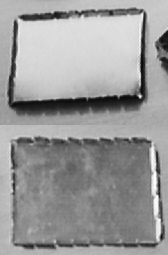 |
Overview
We are going to build a box with electronics. The box is made of metal and
is closed with a lid. We will install mounting screws pointing outward
from it and wires leading from it. Finally we'll solder electronic components
inside. | ![Gallery[168a]](http://images.twibright.com/tns/lvl1/168a.jpg) | |
|
|
![Gallery[182]](http://images.twibright.com/tns/lvl2/182.jpg)
|
Soldering the bottomSolder one lid to the case
so that the case has a bottom. Solder the lid everywhere along the length its edges. (Note: ignore the
holes, I just don't have the right photo without holes.) |
|
|

|
Contact flapsMake contact flaps
on the lid of the case using tin cutters. Adjust their angle using pliers so
that every flap is springed against the case when the lid is closed.
|
|
|
|
|
MechanicsDrill out the case
and assemble with 4 M4 bolts and 12 M4 nuts. The bolts are drawn for
130mm optical head. For 90mm they will be adequately shorter. Apply thermal coupling paste on both sides of the insulating pad
and install BC139 with insulating pad from inner side of the case using M3x6 bolt,
M3 (3.2mm) toothed spring washer and M3 nut. Tighten the M3 nut firmly.
|
|
|
|
|
Transmitter LEDPut the HSDL-42?0 into the 5.3mm
hole in front of transmitter case. Fix it down in straight position using
thermal glue pistol.![Gallery[16b1]](http://images.twibright.com/tns/lvl1/16b1.jpg)
|
|
|
|
|
Preparing cables
Cut a 20cm piece of 1.5mm^2 insulated
double-conductor cord. Cut a 20cm piece of shielded single-conductor. Strip
all ends of these conductors and cover them with a solder. |
|
|
|
|
Stubs
Solder two 1-inch
4mm^2 pieces of (uninsulated) copper hard wire on one end of the two-conductor
cord. Solder another two pieces on one end of the shielded cord. |
|
|
|
|
Cable leadsPut the cable
grommetss in
place into both holes.
Put the bare
ends through the grommets as seen in the picture. Solder particular ends to the
box as seen in the picture. Seal the cables inside the grommet with sillicone
sealant (you can also use thermal glue, it faster).
Note: the pictures are not from Nebulus, but from Metropolis transmitter,
and have tiny difference in LED hole size. |
|
|
![Gallery[13fc]](http://images.twibright.com/tns/lvl2/13fc.jpg)
|
Making the coil
Take the 8.5mm bit bit and wind a 10-turn coil on it from
insulated copper wire of 0.5mm^2...1mm^2 crosssection. | ![Gallery[13fd]](http://images.twibright.com/tns/lvl1/13fd.jpg) | |
|
|
|
|
Fucking chips
Solder together the three 74AC04's in stack (like they are fucking),
pin by pin, all pins. |
|
|
|
|
Key components
Place some
key components according to the plan.
Fix them by soldering on ground if they are connected to ground
or by gluing down with thermal glue gun. Print out the schematic
and retrace with a pencil every
component and wire you solder in:
- U1+2+3 (74AC04)
- Q4 (BD139)
- C11
- Q1, Q2 (2N3904)
- LED1 (HSDL42?0)
![Gallery[1f1c]](http://images.twibright.com/tns/lvl1/1f1c.jpg) |
|
|
 |
Pictures of the circuit
| You can take up the notion how the components, especially blocking
capacitors around the three chips,
are going to be placed inside from
these pictures.
The LED wires are excessively long in this picture. I don't have
a better one. Try to make them short.
| | |
|
|
 |
There are arrows in the schematic labeled as "P*", where "*" varies. Those are not real components but only virtual measuring points. |
|
|
|
|
Place the components in this sequence:
- C20, 21, 22, 23
They are 1n filtering capacitors. They must be soldered as close as possible to
U1+2+3 and ground plane (case) and connected using short, thick (1mm^2) wires.
They are critical from the high-frequency performance point of view because
they store the voltage to be abruptly forced upon the LED at turn-on.
- C24, 25, 26, 27, 28, 29. 22n filtering capacitors. They must be soldered as close as possible to
U1+2+3 and ground plane (case) and connected using short, thick (1mm^2) wires.
They are critical too.
- C12, 13, 14, 15. 100n filtering capacitors. They must be soldered as
U1+2+3 and ground plane (case) and connected using short, thick (1mm^2) wires.
They are critical too.
- C1, C6, C9, C16, C17, C18, C30, C32, C35, R1, R5, R6, R8, R9
- C2, C3, C5, C7, C8, C19, C33, C36, R3, R4, R7, R10, Q3
- C4, C34, C37, L1, R16
- D1, D2, R11, R17
- C10, C31, Q5, R2
- R18
![Gallery[1f1c]](http://images.twibright.com/tns/lvl2/1f1c.jpg) |
|
|
Correctness check
Take the schematic and a multimeter and do a check. Check that the
topology is OK (i. e. the wires lead where they should lead). Measure every
resistor with a multimeter (sometimes it will show less if there is a current
path around). Check every capacitor visually where the value is visible.
Check every diode and transistor junction with diode measuring function of
the multimeter. Scrawl out every part and wire you check on the schematic
with a pencil. |
|
Small schematic
Print out the small schematic (see above, postscript unders schematic)
and shear out the 90x60mm schematic. Overwrite all part
numbers that have been installed different than in schematic. Overwrite all
resistor values that have been chaged during tuning. Write down amplification
factors of both 2N3904 transistors. Glue the paper on the inner side of the
lid. |
|
|
|
Labelling
Print out the Ronja Nebulus label.
Fill in and glue on the
outer side of the lid. |
|
|
Washers and nuts
Save the 4 M4 washers and 4 M4 nuts for future mounting. |
|

